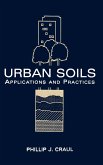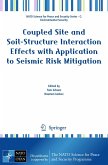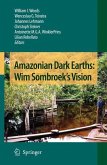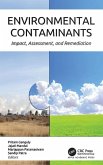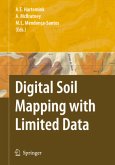- Gebundenes Buch
- Merkliste
- Auf die Merkliste
- Bewerten Bewerten
- Teilen
- Produkt teilen
- Produkterinnerung
- Produkterinnerung
This book presents an in-depth guide to the subject matter and main points of hydrostructural pedology, as theorized for the first time. The authors focus on the underlying concepts, the purpose and role this field plays within agroenvironmental sciences. It is divided into two parts: Part 1 presents the theory behind hydrostructural pedology. The systemic approach applied to the soil is presented, showing how this leads to the thermodynamic formulation of water in the soil's organized medium and to the systemic modeling of soil-water-coupling in natural or anthropic organizations. Part 2…mehr
Andere Kunden interessierten sich auch für
![Humus Chemistry Humus Chemistry]() F J StevensonHumus Chemistry312,99 €
F J StevensonHumus Chemistry312,99 €![Urban Soils Urban Soils]() Phillip J CraulUrban Soils190,99 €
Phillip J CraulUrban Soils190,99 €![Coupled Site and Soil-Structure Interaction Effects with Application to Seismic Risk Mitigation Coupled Site and Soil-Structure Interaction Effects with Application to Seismic Risk Mitigation]() Coupled Site and Soil-Structure Interaction Effects with Application to Seismic Risk Mitigation240,99 €
Coupled Site and Soil-Structure Interaction Effects with Application to Seismic Risk Mitigation240,99 €![Soil, Agriculture, and Ecosystem Modeling Soil, Agriculture, and Ecosystem Modeling]() Soil, Agriculture, and Ecosystem Modeling209,99 €
Soil, Agriculture, and Ecosystem Modeling209,99 €![Amazonian Dark Earths: Wim Sombroek's Vision Amazonian Dark Earths: Wim Sombroek's Vision]() Amazonian Dark Earths: Wim Sombroek's Vision161,99 €
Amazonian Dark Earths: Wim Sombroek's Vision161,99 €![Environmental Contaminants Environmental Contaminants]() Environmental Contaminants198,99 €
Environmental Contaminants198,99 €![Digital Soil Mapping with Limited Data Digital Soil Mapping with Limited Data]() Digital Soil Mapping with Limited Data112,99 €
Digital Soil Mapping with Limited Data112,99 €-
-
-
This book presents an in-depth guide to the subject matter and main points of hydrostructural pedology, as theorized for the first time. The authors focus on the underlying concepts, the purpose and role this field plays within agroenvironmental sciences. It is divided into two parts: Part 1 presents the theory behind hydrostructural pedology. The systemic approach applied to the soil is presented, showing how this leads to the thermodynamic formulation of water in the soil's organized medium and to the systemic modeling of soil-water-coupling in natural or anthropic organizations. Part 2 presents the methodology to complement the first part. In it, the authors determine the hydrostructural characteristics of the pedostructure, characteristic parameters of equilibrium state equations and the hydrostructural functioning of the soil.
Hinweis: Dieser Artikel kann nur an eine deutsche Lieferadresse ausgeliefert werden.
Hinweis: Dieser Artikel kann nur an eine deutsche Lieferadresse ausgeliefert werden.
Produktdetails
- Produktdetails
- Verlag: Wiley
- Seitenzahl: 184
- Erscheinungstermin: 20. Juni 2016
- Englisch
- Abmessung: 240mm x 161mm x 15mm
- Gewicht: 448g
- ISBN-13: 9781848219946
- ISBN-10: 1848219946
- Artikelnr.: 44263765
- Herstellerkennzeichnung
- Libri GmbH
- Europaallee 1
- 36244 Bad Hersfeld
- gpsr@libri.de
- Verlag: Wiley
- Seitenzahl: 184
- Erscheinungstermin: 20. Juni 2016
- Englisch
- Abmessung: 240mm x 161mm x 15mm
- Gewicht: 448g
- ISBN-13: 9781848219946
- ISBN-10: 1848219946
- Artikelnr.: 44263765
- Herstellerkennzeichnung
- Libri GmbH
- Europaallee 1
- 36244 Bad Hersfeld
- gpsr@libri.de
Erik Braudeau is a Senior Scientist in Pedology and Soil Water Physics at the Institute of Research for Development in Marseille, France. Amjad T. Assi is Assistant Research Scientist at the Texas A&M University in Texas, USA. Rabi H. Mohtar is Professor in the Department of Biological and Agricultural Engineering at the Texas A&M University in Texas, USA.
Preface ix
Part 1. Theory of Systemic Modeling of the Pedostructure within the
Hierarchal Hydrofunctional Organization of the Natural Environment 1
Chapter 1. Introduction to Part 1 5
Chapter 2. Inherent Problems of Soil Science 9
2.1. History of pedology 9
2.2. Modeling of water transfers in the soil: supremacy of pedotransfer
functions 11
2.3. Absence of a unitary theory of the description of soil 12
Chapter 3. The Systemic Approach Applied to Pedology 17
3.1. The Bertalanffy project and Le Moigne's general system model 17
3.1.1. The general system theory and Cartesian precepts 17
3.1.2. Systemic representation: Le Moigne's two great ideas 22
3.2. The systemic description of the soil organization 25
3.2.1. Physical definition of a "system" 25
3.2.2. Graduation of spatial axes: the systemic description of soil 28
3.2.3. Systemic modeling of the operating system (OS) on axis III 32
3.2.4. The "Structural Representative Elementary Volume" (SREV) concept
required for the systemic description of the pedon 35
3.3. Systemic physics of the organized soil medium defined on axis III 39
3.3.1. The thermodynamic system of the pedostructure 39
3.3.2. Equations of the hydrostructural equilibrium of the pedostructure 41
3.3.3. Determining hydrostructural soil parameters 44
3.3.4. Equations of the hydrodynamic functioning of the pedostructure 45
3.3.5. The Kamel® model of the hydrostructural functioning of a pedon 50
3.4. Systemic mapping of soil in the landscape 54
3.4.1. Hierarchical hydrofunctional mapping units of the landscape 54
3.4.2. The SIRS-Soils 57
Chapter 4. The General System (GS): General Model of Scientific Disciplines
Related to the Study and Management of Natural Areas 59
4.1. The human system, system of study or management of a natural area,
isomorphic to the general system 59
4.2. Natural systems, OSs of the GS 61
4.3. Information systems of human systems implemented for the study or
management of natural systems 62
4.4. Hydrostructural pedology and its own spatial reference information
system: the SIRS-Soils 64
Chapter 5. Emergence of a New Scientific Discipline: Hydrostructural
Pedology 67
5.1. Where hydrostructural pedology fits into the natural sciences 67
5.2. Specificity of the hydrostructural pedology laboratory 70
5.2.1. Hydrostructural characterization of the pedostructure 70
5.2.2. Experimental analysis of the bio-soil association in the soil column
72
5.2.3. Simulation of processes at the scale of the pedon using a lysimeter
72
Chapter 6. Implications for Agro-environmental Sciences 75
6.1. A unitary theory on the systemic and thermodynamic approaches within
the natural environment 75
6.1.1. Modeling in the natural environment and Cartesian precepts 75
6.1.2. Systematization, theoretical basis of the systemic approach 79
6.1.3. Theoretical and applied systemology 81
6.1.4. General Systems theory of the agro-environmental disciplines 86
6.1.5. Systemic thermodynamics 88
6.2. The new challenge to agro-environmental modeling 92
Part 2. Hydrostructural Characterization of Soil Pedostructure 95
Chapter 7. Introduction to Part 2 99
Chapter 8. Theoretical Recall 103
8.1. Pinpointing the problem 103
8.2. Modeling micro- and macro-water types by the shrinkage curve 104
8.3. New principle for determining the micro-and macro-water types using
the retention curve 107
8.3.1. Micro/macro thermodynamic and hydrostructural equilibrium 107
8.3.2. Equations for the retention curve 108
8.3.3. Equations for the pF curve 112
8.3.4. Equations for the shrinkage curve 114
8.3.5. Equations for hydric conductivity 117
Chapter 9. Methods for Determining the Characteristic Parameters 123
9.1. Soil water retention curve "WRC" 123
9.1.1. Measured using the tensiometer (suction-based method) 123
9.1.2. Measured under air pressure on the porous plate press
(pressure-based method), extending the WRC measurement beyond the 1,000 hPa
tensiometric limit 131
9.2. The shrinkage curve 135
9.2.1. Case of non-sigmoidal shrinkage curves 135
9.2.2. Case of the sigmoidal shrinkage curves 144
9.3. The hydric conductivity curve of the pedostructure 149
9.3.1. Description of the Excel sheets 149
9.3.2. Procedure. 152
9.3.3. Results 153
Conclusion 157
Bibliography 159
Index 165
Part 1. Theory of Systemic Modeling of the Pedostructure within the
Hierarchal Hydrofunctional Organization of the Natural Environment 1
Chapter 1. Introduction to Part 1 5
Chapter 2. Inherent Problems of Soil Science 9
2.1. History of pedology 9
2.2. Modeling of water transfers in the soil: supremacy of pedotransfer
functions 11
2.3. Absence of a unitary theory of the description of soil 12
Chapter 3. The Systemic Approach Applied to Pedology 17
3.1. The Bertalanffy project and Le Moigne's general system model 17
3.1.1. The general system theory and Cartesian precepts 17
3.1.2. Systemic representation: Le Moigne's two great ideas 22
3.2. The systemic description of the soil organization 25
3.2.1. Physical definition of a "system" 25
3.2.2. Graduation of spatial axes: the systemic description of soil 28
3.2.3. Systemic modeling of the operating system (OS) on axis III 32
3.2.4. The "Structural Representative Elementary Volume" (SREV) concept
required for the systemic description of the pedon 35
3.3. Systemic physics of the organized soil medium defined on axis III 39
3.3.1. The thermodynamic system of the pedostructure 39
3.3.2. Equations of the hydrostructural equilibrium of the pedostructure 41
3.3.3. Determining hydrostructural soil parameters 44
3.3.4. Equations of the hydrodynamic functioning of the pedostructure 45
3.3.5. The Kamel® model of the hydrostructural functioning of a pedon 50
3.4. Systemic mapping of soil in the landscape 54
3.4.1. Hierarchical hydrofunctional mapping units of the landscape 54
3.4.2. The SIRS-Soils 57
Chapter 4. The General System (GS): General Model of Scientific Disciplines
Related to the Study and Management of Natural Areas 59
4.1. The human system, system of study or management of a natural area,
isomorphic to the general system 59
4.2. Natural systems, OSs of the GS 61
4.3. Information systems of human systems implemented for the study or
management of natural systems 62
4.4. Hydrostructural pedology and its own spatial reference information
system: the SIRS-Soils 64
Chapter 5. Emergence of a New Scientific Discipline: Hydrostructural
Pedology 67
5.1. Where hydrostructural pedology fits into the natural sciences 67
5.2. Specificity of the hydrostructural pedology laboratory 70
5.2.1. Hydrostructural characterization of the pedostructure 70
5.2.2. Experimental analysis of the bio-soil association in the soil column
72
5.2.3. Simulation of processes at the scale of the pedon using a lysimeter
72
Chapter 6. Implications for Agro-environmental Sciences 75
6.1. A unitary theory on the systemic and thermodynamic approaches within
the natural environment 75
6.1.1. Modeling in the natural environment and Cartesian precepts 75
6.1.2. Systematization, theoretical basis of the systemic approach 79
6.1.3. Theoretical and applied systemology 81
6.1.4. General Systems theory of the agro-environmental disciplines 86
6.1.5. Systemic thermodynamics 88
6.2. The new challenge to agro-environmental modeling 92
Part 2. Hydrostructural Characterization of Soil Pedostructure 95
Chapter 7. Introduction to Part 2 99
Chapter 8. Theoretical Recall 103
8.1. Pinpointing the problem 103
8.2. Modeling micro- and macro-water types by the shrinkage curve 104
8.3. New principle for determining the micro-and macro-water types using
the retention curve 107
8.3.1. Micro/macro thermodynamic and hydrostructural equilibrium 107
8.3.2. Equations for the retention curve 108
8.3.3. Equations for the pF curve 112
8.3.4. Equations for the shrinkage curve 114
8.3.5. Equations for hydric conductivity 117
Chapter 9. Methods for Determining the Characteristic Parameters 123
9.1. Soil water retention curve "WRC" 123
9.1.1. Measured using the tensiometer (suction-based method) 123
9.1.2. Measured under air pressure on the porous plate press
(pressure-based method), extending the WRC measurement beyond the 1,000 hPa
tensiometric limit 131
9.2. The shrinkage curve 135
9.2.1. Case of non-sigmoidal shrinkage curves 135
9.2.2. Case of the sigmoidal shrinkage curves 144
9.3. The hydric conductivity curve of the pedostructure 149
9.3.1. Description of the Excel sheets 149
9.3.2. Procedure. 152
9.3.3. Results 153
Conclusion 157
Bibliography 159
Index 165
Preface ix
Part 1. Theory of Systemic Modeling of the Pedostructure within the
Hierarchal Hydrofunctional Organization of the Natural Environment 1
Chapter 1. Introduction to Part 1 5
Chapter 2. Inherent Problems of Soil Science 9
2.1. History of pedology 9
2.2. Modeling of water transfers in the soil: supremacy of pedotransfer
functions 11
2.3. Absence of a unitary theory of the description of soil 12
Chapter 3. The Systemic Approach Applied to Pedology 17
3.1. The Bertalanffy project and Le Moigne's general system model 17
3.1.1. The general system theory and Cartesian precepts 17
3.1.2. Systemic representation: Le Moigne's two great ideas 22
3.2. The systemic description of the soil organization 25
3.2.1. Physical definition of a "system" 25
3.2.2. Graduation of spatial axes: the systemic description of soil 28
3.2.3. Systemic modeling of the operating system (OS) on axis III 32
3.2.4. The "Structural Representative Elementary Volume" (SREV) concept
required for the systemic description of the pedon 35
3.3. Systemic physics of the organized soil medium defined on axis III 39
3.3.1. The thermodynamic system of the pedostructure 39
3.3.2. Equations of the hydrostructural equilibrium of the pedostructure 41
3.3.3. Determining hydrostructural soil parameters 44
3.3.4. Equations of the hydrodynamic functioning of the pedostructure 45
3.3.5. The Kamel® model of the hydrostructural functioning of a pedon 50
3.4. Systemic mapping of soil in the landscape 54
3.4.1. Hierarchical hydrofunctional mapping units of the landscape 54
3.4.2. The SIRS-Soils 57
Chapter 4. The General System (GS): General Model of Scientific Disciplines
Related to the Study and Management of Natural Areas 59
4.1. The human system, system of study or management of a natural area,
isomorphic to the general system 59
4.2. Natural systems, OSs of the GS 61
4.3. Information systems of human systems implemented for the study or
management of natural systems 62
4.4. Hydrostructural pedology and its own spatial reference information
system: the SIRS-Soils 64
Chapter 5. Emergence of a New Scientific Discipline: Hydrostructural
Pedology 67
5.1. Where hydrostructural pedology fits into the natural sciences 67
5.2. Specificity of the hydrostructural pedology laboratory 70
5.2.1. Hydrostructural characterization of the pedostructure 70
5.2.2. Experimental analysis of the bio-soil association in the soil column
72
5.2.3. Simulation of processes at the scale of the pedon using a lysimeter
72
Chapter 6. Implications for Agro-environmental Sciences 75
6.1. A unitary theory on the systemic and thermodynamic approaches within
the natural environment 75
6.1.1. Modeling in the natural environment and Cartesian precepts 75
6.1.2. Systematization, theoretical basis of the systemic approach 79
6.1.3. Theoretical and applied systemology 81
6.1.4. General Systems theory of the agro-environmental disciplines 86
6.1.5. Systemic thermodynamics 88
6.2. The new challenge to agro-environmental modeling 92
Part 2. Hydrostructural Characterization of Soil Pedostructure 95
Chapter 7. Introduction to Part 2 99
Chapter 8. Theoretical Recall 103
8.1. Pinpointing the problem 103
8.2. Modeling micro- and macro-water types by the shrinkage curve 104
8.3. New principle for determining the micro-and macro-water types using
the retention curve 107
8.3.1. Micro/macro thermodynamic and hydrostructural equilibrium 107
8.3.2. Equations for the retention curve 108
8.3.3. Equations for the pF curve 112
8.3.4. Equations for the shrinkage curve 114
8.3.5. Equations for hydric conductivity 117
Chapter 9. Methods for Determining the Characteristic Parameters 123
9.1. Soil water retention curve "WRC" 123
9.1.1. Measured using the tensiometer (suction-based method) 123
9.1.2. Measured under air pressure on the porous plate press
(pressure-based method), extending the WRC measurement beyond the 1,000 hPa
tensiometric limit 131
9.2. The shrinkage curve 135
9.2.1. Case of non-sigmoidal shrinkage curves 135
9.2.2. Case of the sigmoidal shrinkage curves 144
9.3. The hydric conductivity curve of the pedostructure 149
9.3.1. Description of the Excel sheets 149
9.3.2. Procedure. 152
9.3.3. Results 153
Conclusion 157
Bibliography 159
Index 165
Part 1. Theory of Systemic Modeling of the Pedostructure within the
Hierarchal Hydrofunctional Organization of the Natural Environment 1
Chapter 1. Introduction to Part 1 5
Chapter 2. Inherent Problems of Soil Science 9
2.1. History of pedology 9
2.2. Modeling of water transfers in the soil: supremacy of pedotransfer
functions 11
2.3. Absence of a unitary theory of the description of soil 12
Chapter 3. The Systemic Approach Applied to Pedology 17
3.1. The Bertalanffy project and Le Moigne's general system model 17
3.1.1. The general system theory and Cartesian precepts 17
3.1.2. Systemic representation: Le Moigne's two great ideas 22
3.2. The systemic description of the soil organization 25
3.2.1. Physical definition of a "system" 25
3.2.2. Graduation of spatial axes: the systemic description of soil 28
3.2.3. Systemic modeling of the operating system (OS) on axis III 32
3.2.4. The "Structural Representative Elementary Volume" (SREV) concept
required for the systemic description of the pedon 35
3.3. Systemic physics of the organized soil medium defined on axis III 39
3.3.1. The thermodynamic system of the pedostructure 39
3.3.2. Equations of the hydrostructural equilibrium of the pedostructure 41
3.3.3. Determining hydrostructural soil parameters 44
3.3.4. Equations of the hydrodynamic functioning of the pedostructure 45
3.3.5. The Kamel® model of the hydrostructural functioning of a pedon 50
3.4. Systemic mapping of soil in the landscape 54
3.4.1. Hierarchical hydrofunctional mapping units of the landscape 54
3.4.2. The SIRS-Soils 57
Chapter 4. The General System (GS): General Model of Scientific Disciplines
Related to the Study and Management of Natural Areas 59
4.1. The human system, system of study or management of a natural area,
isomorphic to the general system 59
4.2. Natural systems, OSs of the GS 61
4.3. Information systems of human systems implemented for the study or
management of natural systems 62
4.4. Hydrostructural pedology and its own spatial reference information
system: the SIRS-Soils 64
Chapter 5. Emergence of a New Scientific Discipline: Hydrostructural
Pedology 67
5.1. Where hydrostructural pedology fits into the natural sciences 67
5.2. Specificity of the hydrostructural pedology laboratory 70
5.2.1. Hydrostructural characterization of the pedostructure 70
5.2.2. Experimental analysis of the bio-soil association in the soil column
72
5.2.3. Simulation of processes at the scale of the pedon using a lysimeter
72
Chapter 6. Implications for Agro-environmental Sciences 75
6.1. A unitary theory on the systemic and thermodynamic approaches within
the natural environment 75
6.1.1. Modeling in the natural environment and Cartesian precepts 75
6.1.2. Systematization, theoretical basis of the systemic approach 79
6.1.3. Theoretical and applied systemology 81
6.1.4. General Systems theory of the agro-environmental disciplines 86
6.1.5. Systemic thermodynamics 88
6.2. The new challenge to agro-environmental modeling 92
Part 2. Hydrostructural Characterization of Soil Pedostructure 95
Chapter 7. Introduction to Part 2 99
Chapter 8. Theoretical Recall 103
8.1. Pinpointing the problem 103
8.2. Modeling micro- and macro-water types by the shrinkage curve 104
8.3. New principle for determining the micro-and macro-water types using
the retention curve 107
8.3.1. Micro/macro thermodynamic and hydrostructural equilibrium 107
8.3.2. Equations for the retention curve 108
8.3.3. Equations for the pF curve 112
8.3.4. Equations for the shrinkage curve 114
8.3.5. Equations for hydric conductivity 117
Chapter 9. Methods for Determining the Characteristic Parameters 123
9.1. Soil water retention curve "WRC" 123
9.1.1. Measured using the tensiometer (suction-based method) 123
9.1.2. Measured under air pressure on the porous plate press
(pressure-based method), extending the WRC measurement beyond the 1,000 hPa
tensiometric limit 131
9.2. The shrinkage curve 135
9.2.1. Case of non-sigmoidal shrinkage curves 135
9.2.2. Case of the sigmoidal shrinkage curves 144
9.3. The hydric conductivity curve of the pedostructure 149
9.3.1. Description of the Excel sheets 149
9.3.2. Procedure. 152
9.3.3. Results 153
Conclusion 157
Bibliography 159
Index 165



